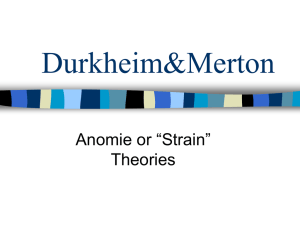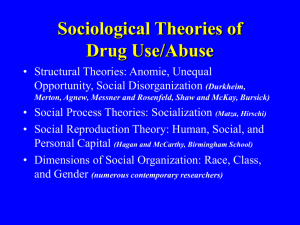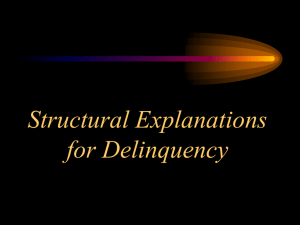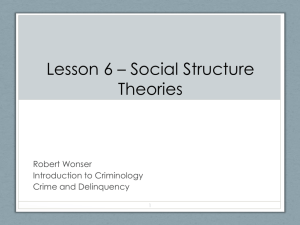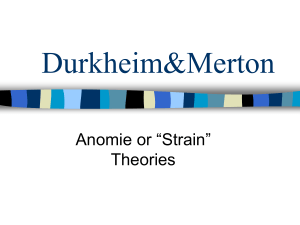Ch. 5 - MDC Faculty Home Pages
advertisement
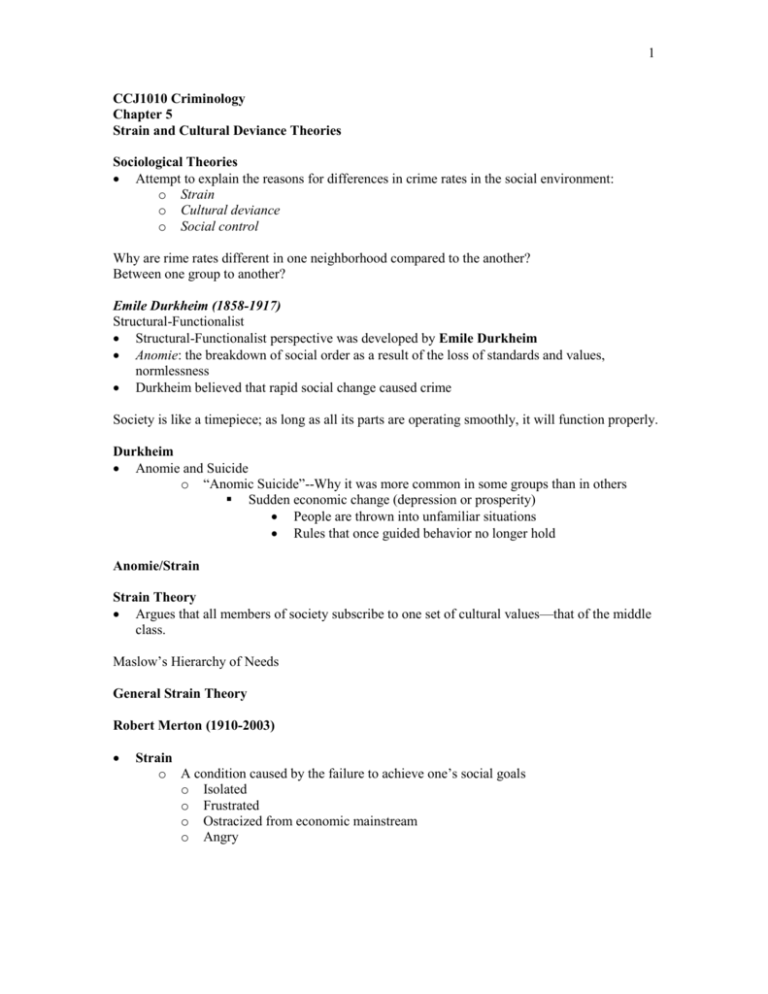
1 CCJ1010 Criminology Chapter 5 Strain and Cultural Deviance Theories Sociological Theories Attempt to explain the reasons for differences in crime rates in the social environment: o Strain o Cultural deviance o Social control Why are rime rates different in one neighborhood compared to the another? Between one group to another? Emile Durkheim (1858-1917) Structural-Functionalist Structural-Functionalist perspective was developed by Emile Durkheim Anomie: the breakdown of social order as a result of the loss of standards and values, normlessness Durkheim believed that rapid social change caused crime Society is like a timepiece; as long as all its parts are operating smoothly, it will function properly. Durkheim Anomie and Suicide o “Anomic Suicide”--Why it was more common in some groups than in others Sudden economic change (depression or prosperity) People are thrown into unfamiliar situations Rules that once guided behavior no longer hold Anomie/Strain Strain Theory Argues that all members of society subscribe to one set of cultural values—that of the middle class. Maslow’s Hierarchy of Needs General Strain Theory Robert Merton (1910-2003) Strain o A condition caused by the failure to achieve one’s social goals o Isolated o Frustrated o Ostracized from economic mainstream o Angry 2 Anomie Normlessness produced by rapidly shifting moral values; occurs when personal goals cannot be achieved using available means Youths use deviant methods to achieve goals Youths reject socially accepted goals and substitute deviant ones o Drug users/alcoholics Robert Merton Modes of Adaptation Conformity: Most common. Individuals accept the culturally defined goals and the prescribed means for achieving those goals. Innovation: Individuals accept society’s goals, but design their own means for achieving them. Ritualism: Abandon society’s goals and concentrate only on the means. Conformity Innovation Ritualism Robert Merton Modes of Adaptation (Continued) Retreatism: Individuals who give up on the goals and the means. Rebellion: Individuals who reject the cultural goals and the cultural means and substitute new cultural goals and means. Retreatism Rebellion Merton’s Modes of Individual Adaptation Social Class and Crime A summary of more than 100 projects concluded that “lower-class people do commit those direct interpersonal types of crime which are normally handled by the police at a higher rate than middle-class people.” The Goal of Economic Success Causes: The devaluation of noneconomic roles and functions The accommodation of other institutions to economic needs The penetration of economic norms General Strain Theory Robert Agnew Strain caused by failure to achieve positively valued goals o Aspire wealth and fame but assume such goals are impossible to achieve o Compare themselves to peers who seem to be doing better o Believe they are not being treated fairly by a parent or a teacher Strain as the removal of positively valued stimuli o Loss of boyfriend/girlfriend 3 o Death of loved one o Parental divorce Strain as the presentation of negative stimuli o Pain-inducing social interactions Child abuse Criminal victim School failure Strain-producing events Each type of strain increases an individual’s feelings of anger, fear, or depression. The most critical reaction for general strain theory is anger Increases desire for revenge Helps justify aggressive behavior Crime Preventions Strategies Based on Strain Theory Head Start o Improves socially competence of low-income children Perry Preschool Project o Provide children with the skills needs to get ahead at school and the workplace Job Corps o Aimed at “the worst of the worst” o Enables neglected teenagers to master work habits not learned at home Cultural Deviance Theories Cultural deviance theories claim that lower-class people have a different set of values, which tend to conflict with the values of the middle-class. Social Disorganization Theory Shaw and McKay Crime rates were differentially distributed throughout the city, and areas of high crime rates had high rates of other community problems. Most delinquency occurred in the areas nearest the central business district and decreased with the distance from the center. Some areas consistently suffered high delinquency rates, regardless of the ethnic makeup of the population. Social Disorganization Theory -- Shaw and McKay (Continued) High delinquency areas were characterized by a high percentage of immigrants, nonwhites, lowincome families, and a low percentage of home ownership. In high-delinquency areas there was a general acceptance of nonconventional norms, but these norms competed with conventional ones held by some of the inhabitants. Natural Urban Areas of Chicago Park and Burgess Concentric Zones Transitional zones areas heaviest with delinquency Zones farthest from center, least prone to delinquency 4 Natural Urban Areas of Chicago Park and Burgess Community based delinquency- prevention programs Social Control The ability of a healthy, organized community to regulate itself Disorganized areas are not capable of social control because wracked with deterioration and economic failure Lack after school programs Informal/formal forms of social control frayed Kids free to mix with deviant peers More likely to use drugs Edwin Sutherland (1883-1950) Differential Association Theory Criminal behavior is learned primarily in interpersonal groups, and youths will become delinquent if definitions they learn in those groups that are favorable to violating the law exceed definitions favorable to obeying the law Edwin Sutherland Differential Association Theory 1. Criminal behavior is learned. 2. Criminal behavior is learned in interaction with other persons in a process of communication. 3. The principle part of the learning of criminal behavior occurs within intimate personal groups. Edwin Sutherland Differential Association Theory (Continued) 4. When criminal behavior is learned, the learning includes (a) techniques of committing the crime, and (b) the specific direction of motives, drives, rationalizations, and attitudes. 5. The specific direction of motives and drives is learned from definitions of the legal codes as favorable or unfavorable. Edwin Sutherland Differential Association Theory (Continued) 6. A person becomes delinquent because of an excess of definitions favorable to violation of law over definitions unfavorable to violation of law. 7. Differential associations may vary in frequency, duration, priority, and intensity. Edwin Sutherland Differential Association Theory (Continued) 8. The process of learning criminal behavior by association with criminal and anti-criminal patterns involves all the mechanisms that are involved in any other learning. 9. While criminal behavior is an expression of general needs and values, it is not explained by those general needs and values, since noncriminal behavior is an expression of the same needs and values. 5 Culture Conflict Theory Culture conflict theory focuses on the source of criminal norms and attitudes. According to Thorsten Sellin, conduct norms-- norms that regulate our daily lives--are rules that reflect the attitudes of the groups to which each of us belong. The norms define what is considered normal or abnormal behavior. Cultural Deviance Theory Links delinquent acts to the formation of independent subcultures with a unique set of values that clash with the mainstream culture Culture Conflict – Elijah Anderson – “Code of the Streets” o When the values of a subculture clash with those of the dominant culture Lower-class values o Being tough o Defying authority o Not showing fear o Using your wits o Sexual conquest means of achieving self-respect End of Chapter 5
